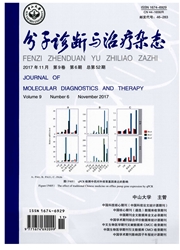

 中文摘要:
中文摘要:
合成致死(Synthetic lethality)作用即生物体内多个基因共突变时,会造成无法被机体本身调控机制修复的DNA损伤,引发细胞凋亡。以DNA损伤反应与修复网络为背景,通过细胞信号通路中关键位点基因的共突变,来解决肿瘤细胞治疗过程中的凋亡逃避,为特定基因遗传背景的肿瘤治疗提供了特异性、个体化的治疗方案。三阴性乳腺癌(Triple negative breast cancer,TNBC)通常伴有brca基因缺陷,对其合成致死作用的发现和深入研究也为恶性肿瘤治疗提供了新的方向。本文针对目前研究较为透彻的合成致死基因位点的作用原理及意义进行概述,包括brca、p53、atm/atr等。同时讨论了合成致死作用在自杀基因系统和药物化疗两种恶性肿瘤治疗方案中可能存在的积极作用。
 英文摘要:
英文摘要:
Synthetic lethality is a phenomenon that the cell apoptosis generate when correlative mutations of two or more genes happen in one cell. Regarding the network of DNA damage respond and repair as the background, synthetic lethality may provide a feasible proposal to deal with the apoptosis escapement within cancer cells, and will hopefully give a new method for treating DNA repair-defective human cancers. The defect of brca gene leads this phenomenon in triple negative breast cancer, which is a fundament to further this research. In this review, we discuss recent advances including the breast cancer susceptibility gene, p53, atm/atr and so forth. At the same time, we analyse some appearing pathways in posse when the synthetic lethality phenomenon combined with a system of suicide genes or chemotherapeutics.
 同期刊论文项目
同期刊论文项目
 同项目期刊论文
同项目期刊论文
 期刊信息
期刊信息
